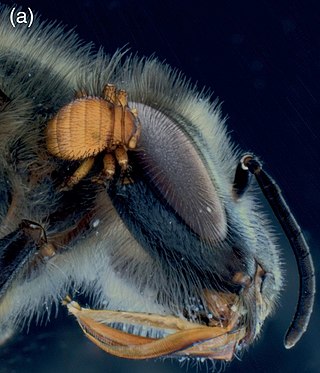
Braulidae, or bee lice, is a family of true flies (Diptera) with seven species in two genera, Braula and Megabraula. They are found in honey bee colonies due to their phoretic, inquiline, and kleptoparasitic relationships with the bees. Similar in appearance but not closely related to keds, these flies are also small, wingless, and occasionally mistaken for mites or lice, hence their common name.
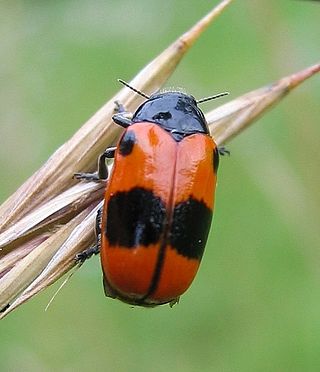
The Clytrini are a tribe within the leaf beetle subfamily Cryptocephalinae, though historically they were often treated as a distinct subfamily, Clytrinae. As the other Cryptocephalinae, they belong to the group of case-bearing leaf beetles known as Camptosomata.

Endomychidae, or handsome fungus beetles, is a family of beetles with representatives found in all biogeographic realms. There are around 120 genera and 1300 species. The family was established based on the type genus Endomychus, a genus erected in 1795 by Panzer which was applied to a species that Linnaeus called Chrysomela coccinea. As the common name suggests, Endomychidae feed on fungi. Crowson, in his influential treatment of the beetles, placed the family within the Cucujoidea. They have a tarsal formal of 4-4-4 or 3-3-3 and the wings lack a closed radial cell. The second antennal segment has a sensory appendage that is as long as the third antennal segment. The family has also been grouped with the Coccinellidae in a group called the Trimera for having pseudotrimerous tarsi. A 2015 molecular phylogeny study found that the Cucujoidea were found to be non-monophyletic and the Endomychidae was refined with the removal of the Anamorphinae from within the family and elevated to the status of a full family, Anamorphidae. Mycetaeinae and Eupsilobiinae were also found not to belong within the clades of the core Endomychidae, and likewise reclassified into the families Mycetaeidae and Eupsilobiidae.

Stenocrepis is a genus of beetles in the family Carabidae, containing the following 31 species:

Chalcolepidius is a genus of beetles in the family Elateridae.

Phryneta is a genus of flat-faced longhorn beetles belonging to the family Cerambycidae.

Phrynetini is a tribe of longhorn beetles of the subfamily Lamiinae. It was described by Thomson in 1864.

Ceroplesini is a tribe of longhorn beetles of the subfamily Lamiinae. It was described by Thomson in 1860.
Tragocephalini is a tribe of longhorn beetles of the subfamily Lamiinae. It was described by James Thomson in 1857.
Phryneta hecphora is a species of beetle in the family Cerambycidae. It was described by James Thomson in 1857. It is known from Mozambique and Democratic Republic of the Congo.

Phryneta macularis is a species of beetle in the family Cerambycidae. It was described by Harold in 1879. It is known from the Democratic Republic of the Congo and Angola.
Phryneta aurivillii is a species of beetle in the family Cerambycidae. It was described by Hintz in 1913. It is known from the Democratic Republic of the Congo and Cameroon.
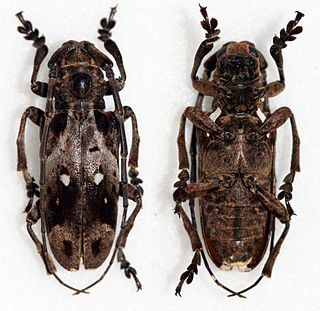
Phryneta bulbifera is a species of beetle in the family Cerambycidae. It was described by Hermann Julius Kolbe in 1894, originally under the genus Phrystola. It is known from the Democratic Republic of the Congo and Cameroon.
Phryneta crassa is a species of beetle in the family Cerambycidae. It was described by Karl Jordan in 1903. It is known from the Central African Republic, Gabon, and the Democratic Republic of the Congo.
Phryneta ellioti is a species of beetle in the family Cerambycidae. It was described by Charles Joseph Gahan in 1909. It is known from Uganda and the Democratic Republic of the Congo.
Phryneta obliquata is a species of beetle in the family Cerambycidae. It was described by Harold in 1878. It is known from Tanzania, Uganda, Somalia, the Democratic Republic of the Congo, Ethiopia and Kenya.
Phryneta pallida is a species of beetle in the family Cerambycidae. It was described by James Thomson in 1857. It is known from South Africa.
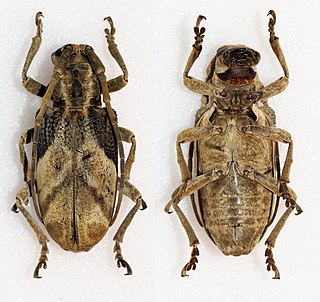
Phryneta semirasa is a species of beetle in the family Cerambycidae. It was described by Dohrn in 1885. It is known from Tanzania, the Democratic Republic of the Congo, Mozambique, Zimbabwe, Malawi, and Zambia.
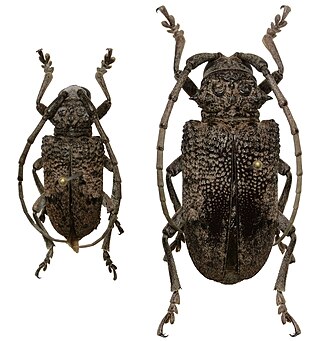
Phryneta spinator, the fig-tree borer longhorn beetle or fig tree borer, is a species of beetle in the family Cerambycidae. It was described by Johan Christian Fabricius in 1792, originally under the genus Lamia. It has a wide distribution throughout Africa. It feeds on Pyrus communis, Ficus carica, Salix babylonica, Cupressus sempervirens, and Vitis vinifera.
Baraeus taeniolatus is a species of beetle in the family Cerambycidae. It was described by Louis Alexandre Auguste Chevrolat in 1857. It is known from the Ivory Coast, the Democratic Republic of the Congo, Sierra Leone, the Central African Republic, Nigeria, and Togo.










